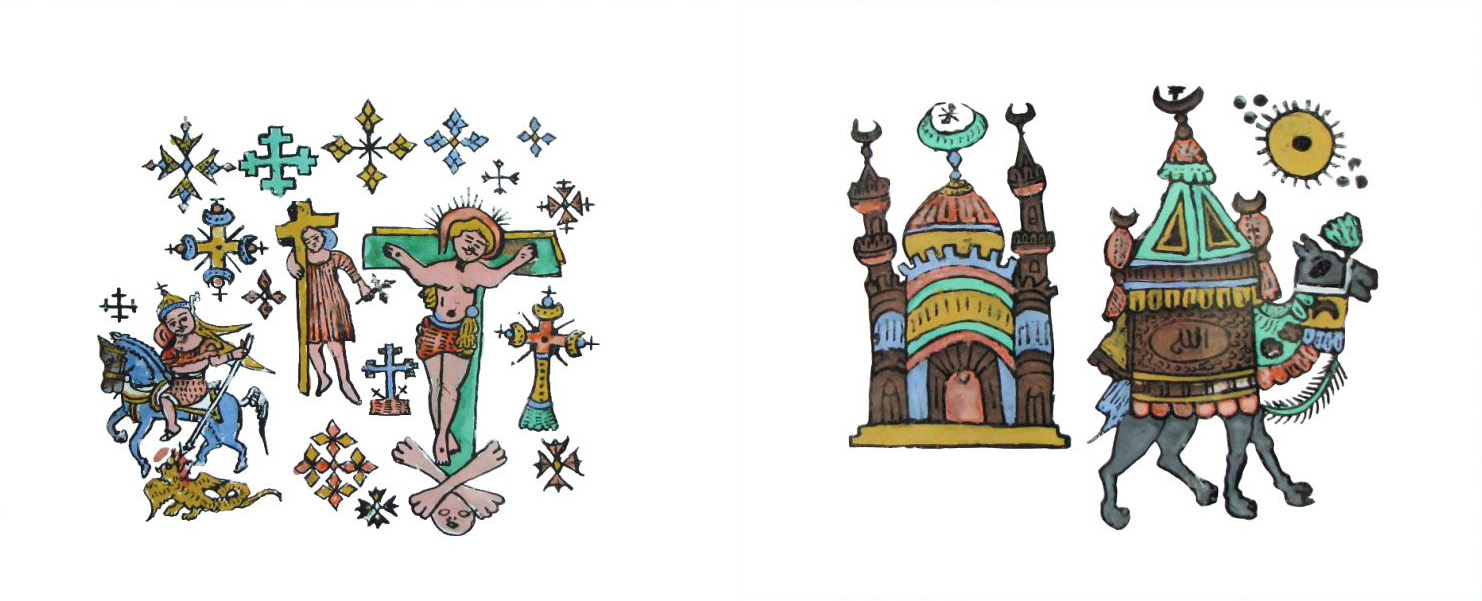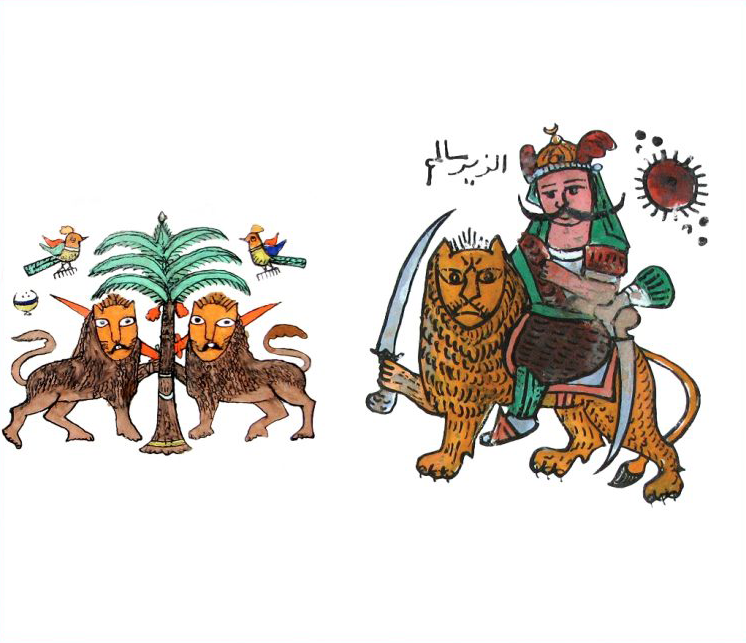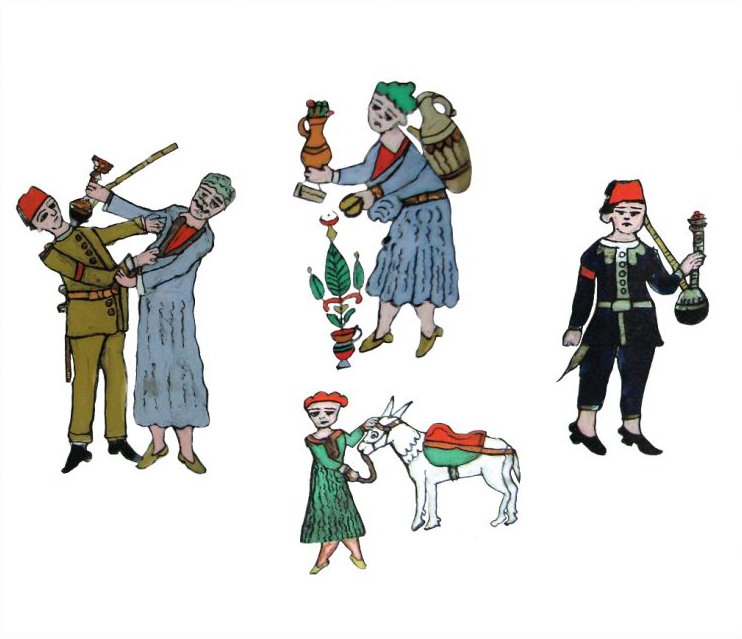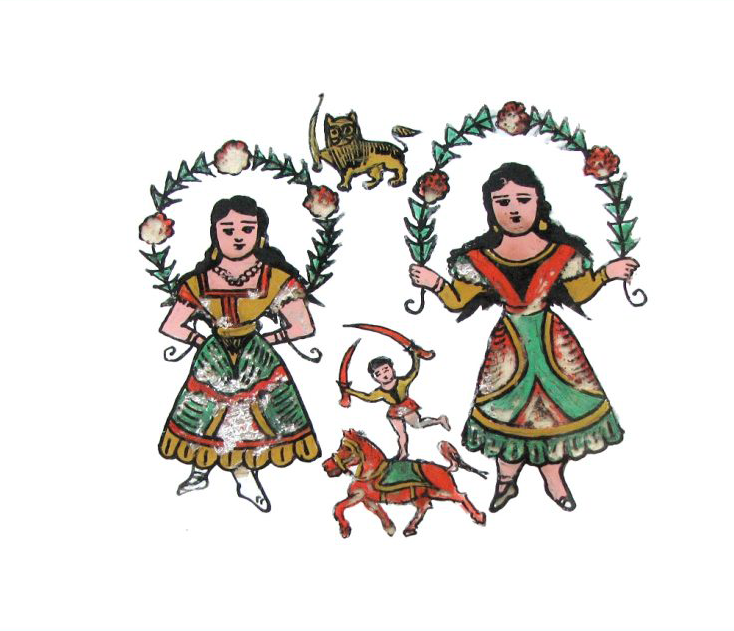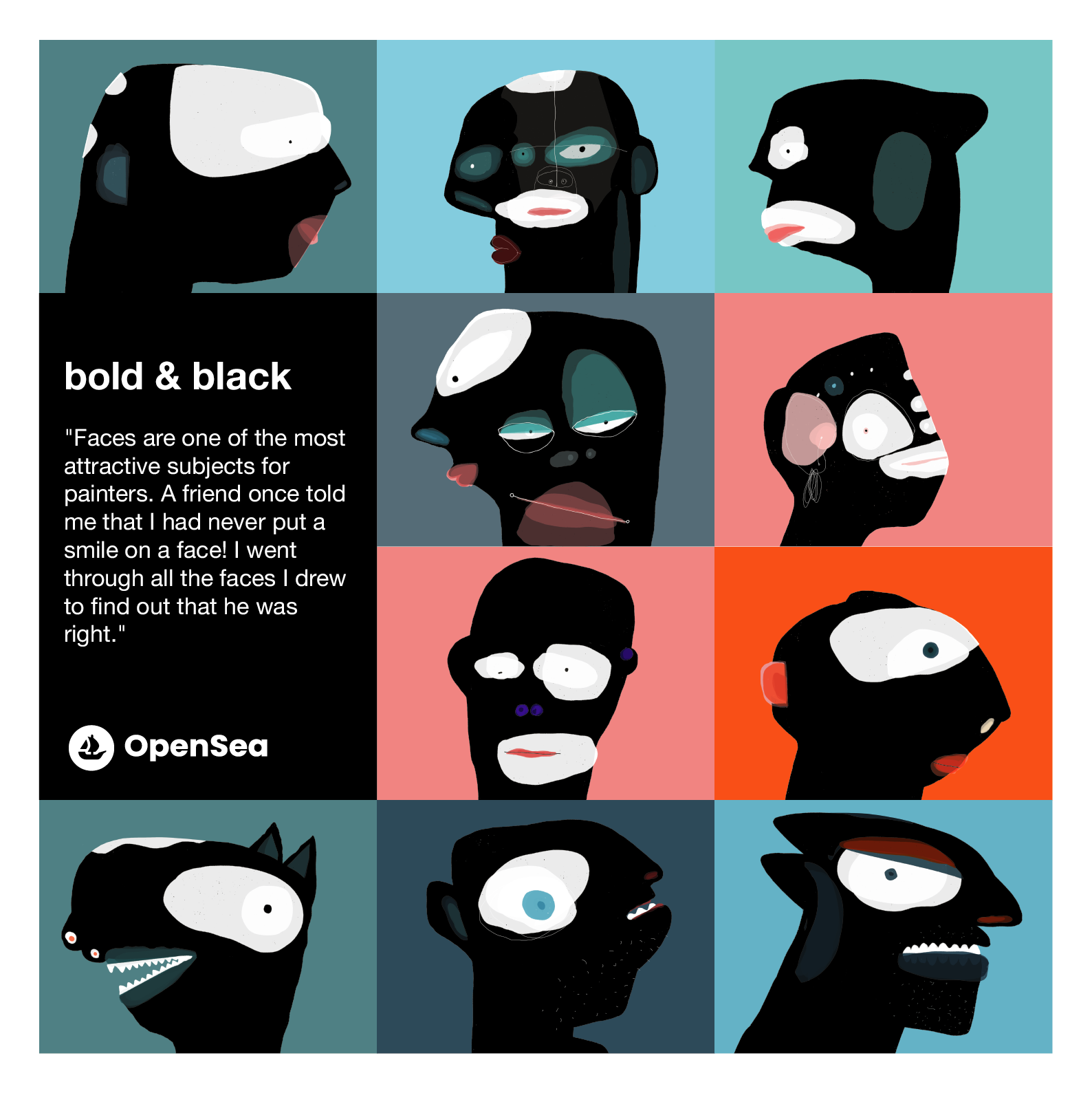This piece about Egyptian tattoos was first published in Rawi Magazine by Emmanuelle Perrin. Rawi has given Design Repository permission to republish this article.
Much more than simple body adornments, traditional Egyptian tattoos incorporate complex meanings and evoke tales of knights, seductresses and animals in a multicolour world of the imagination.
Over the years, Egyptian tattoos have manifested themselves in many different forms, from geometric shapes, both ornamental and medical, to inkings with religious themes, symbolic bestiaries and figures of men and women. The evocative force of these symbols – with their multifarious meanings – is striking. Today, thanks to the collections of tattoo artists, painted on glass and preserved since the 1930s at the Museum of the Geographical Society (Cairo) and at the Museum of Quai Branly (Paris), it is possible to assemble an inventory of this unique and extraordinary art form.

The meaning behind these complex images can only be understood through the analysis of many types of sources, from miniatures, chromolithographs, bestiaries and cosmogonies, to fables and proverbs, literary motifs and the legends of saints. A knowledge of magic, divination and religious beliefs is also key. Once armed with this understanding, it becomes possible to delve into the multi-coloured world of Egyptian tattoos, a place populated by birds, fish, lions, snakes, crosses, mosques, knights and women brandishing sabres. A place that excites the imagination.

Jewellery and Amulets
The famous work of Edward Lane, An Account of the Manners and Customs of the Modern Egyptians (American University in Cairo Press, Reprint Edition 2012), originally published in 1836, features a woman tattooed between her breasts, down the length of an arm, above her eyebrows, the chin and hands. The ornamental and erotic nature of these tattoos is immediately apparent. Many authors have also highlighted the use of ‘medical tattoos’ for treating headaches, bone and joint lesions, skin disease, stomach ailments and toothache or inflammation. Geometric tattoos also have protective virtues; this is seen in Winifred Blackman’s The Fellahin of Upper Egypt (American University in Cairo Press, 2000), originally published in 1927, in which tattoos are said to protect children from the evil doppelgangers of their mothers, who threaten to abduct their human sisters’ children. In the Maghreb, mothers ‘who eat [their] children’ and have lost several successive infants are tattooed with ‘medico-magical’ figures, as are their surviving children.
Religious Motifs
Among Christian motifs, we find figures of Christ as well as representations of Saint George and Saint Michael. The equal-armed cross, often adorned with flowerets or brackets is one of the most popular and varied motifs. Copts frequently tattoo themselves, often from childhood. Following a ritual in practice since the eighth century, a cross is tattooed on the wrist or between the thumb and forefinger, giving the bearer assurance of burial in consecrated ground or acting as proof of his faith on the Day of Judgment. For Muslims, the motifs differed. Besides the crescent, so often present in these geometric and floral compositions, they also include mosques and dromedaries (camels) driving a caravan of pilgrims from Mecca. These Muslim motifs could attest to a pilgrimage to Mecca, Medina or to the grave of a saint.
Bestiary / Animals

The Bird of Thought
Called ‘bird of thought’ (asfur el-fikr), this motif is tattooed between the eye and the temple as a remedy for headaches and ‘weakness of spirit’. Various proverbs connect the bird, the head and thought. A person absorbed in their thoughts, for example, is said to be immobile, ‘as if a bird was perched on their head’. The phrase, ‘the birds made his head fly’, on the other hand, signifies a fit of anger. Furthermore, the expression ‘he was tattooed in birds’ is used to describe someone of great stupidity; this is in reference to the conflict between farmers and city dwellers, as found in the saying, ‘You may civilize the farmer, but his tattoo is indelible’.
The Fish: Fertile and Nourishing
The fish often appears as a symbol of fertility, while to Copts it is associated with Christ; the Greek word for fish (ikhthus) is the acrostic of Jesus Christ, Son of God, Saviour, who is also a ‘fisher of souls’. When appearing in the form of fish-shaped amulets, the symbol is both curative and protective. Through the image of a siren, a female aspect to the motif is incorporated, evident in the symbol of the bust of a woman emerging from the mouth of a fish.
Lion Combatant, Lion Tamed
Lions often appear armed, tamed, chained to a palm tree, held on a leash by an armed woman or mounted by a man. The motif of the lion trampling a snake – a battle between a solar animal and a chthonic animal – could symbolize the victory of good over evil. An ambivalent figure, the lion represents qualities of bravery, magnanimity and strength, as well as savagery and ferocity. The animal also represents the attributes of holy people, such as Ali, son-in-law of the Prophet, and the ‘lion of God’, Saint Mark, who evangelized Egypt. Numerous saints transform into the form of a lion, which demonstrates their mastery of nature and desire.
The Snake: Fear and Power
Beyond its well-known phallic undertones, the symbolism of the serpent is particularly complex. In the interpretation of dreams, as in proverbs, it appears essentially as an enemy and evildoer. Proverbs introduce other images, however: ‘If a snake comes to love you, wrap it around your neck’, one says. ‘Near to a scorpion, venture not, but near to a snake, make your bed and sleep’, says another. According to 9th century Muslim scholar Jahiz, along with the crab and the fish, the snake figures among the most respectable of God’s creations; it was said to be blessed with an extraordinary longevity and prodigious strength. Does this considerable power inspire these tattoos, or do the tattoos possess the ability to dominate such powers?
The Rooster: A Clear-eyed, Masculine Animal
Roosters are well known for their virility; it is thus said that a man who is courageous, proud and dominant has ‘become a rooster’. It is also a solar symbol, since the rooster’s song announces the birth of the day; from this stems its reputation as ‘clear-eyed’ in nature. Roosters are equally tied to the celestial world: their benign song is said to be triggered by the vision of an angel, in contrast to the braying of a donkey, which is caused by a demon. In creationist myths, roosters echo the song of an enormous angelic rooster, who lives in paradise under the throne of God and announces the hours of prayer.
The Goat: Nurturing and Submissive
Analogies with leonine motifs suggest that the goat form – as a symbol of the sun, like the lion and the rooster – is a ‘force’ that can be tamed by chaining it to a palm tree under the banner of Islam. Through its milk, hair and leather, the goat is a symbol of nurture, evoking in equal measure vitality, capriciousness and unpredictability. Perhaps because the animal climbs along the tops of mountains, to Christians it is often associated with strong vision. Given its status as a common form of livestock – especially when compared to camels, whose breeding is more prestigious – the goat may symbolize moderation and modesty. Finally, the goat is regarded as shameless, since, unlike sheep, its tail does not cover its rear.
Male Characters
Figures Loved, Rebellious and Virile
Various motifs appear among tattoos of male figures, such as those associated with trade or profession, including donkey drivers, juice or liquorice syrup sellers and policemen. These motifs may represent loved ones, whether identified by profession or not. Acrobats figure frequently among these drawings too, perhaps representing a reversal of values. In another form of challenge to the established order, certain representations show a fight between a man and a policeman. Indeed, tattoos have often been associated with criminality. Alexandre Lacassagne (1843–1924), a doctor from Lyon, in his work on psychology and criminal anthropology, was deeply interested in the subject of prison tattoos, while one Mr. Caloyanni, counselor to Cairo’s High Court proposed a ‘study of the tattoos of Egypt’s criminals’. He considered tattooing to be the mark of delinquency and prostitution, writing, ‘Indeed, every tattooed man … is a criminal addicted to hashish, opium and their derivatives. Women with these signs are prostitutes and juveniles’. The motif of the knight, whether on horseback or atop a lion, is the most commonly attested male figure. This armoured knight sports an immense moustache and a winged helmet sometimes topped with a crescent. He may be identified as Antar ibn Shadad, sublime hero of the Sirat Antar, model of knighthood from numerous Arab novels. He represents masculine virtues: virility, bravery, generosity, loyalty and the protection of the weak. The ‘image of all that a man can become’, the knight symbolizes mastery – mastery of his mount, be it even a lion, and the mastery of the cause that he serves.
Female Characters
Figures of Desire and the Woman of Two Faces
Widely represented as figures of desire and seduction, women are presented dressed in their finery. As a symbol of sensual provocation, they have unfurled hair and often wear plentiful and heavy jewellery. A first series of motifs evokes the ‘arusa, the doll, the fiancée, or the young bride, and women as birds or flowers. Other drawings evoke motifs of union and fertility, including couples walking and shaking hands, with a woman’s bust at the centre or a floral decoration, her hand holding a bouquet. They also feature a mother carrying a child in her arms or with a child riding on her shoulders. The image of the seductress asserts itself through the poetic and gallant motif of a woman with a jar. There is also an entire series of women given masculine attributes, including women with hookahs, women with rifles or brandishing sabres. Images of naked, dancing courtesans also feature prominently, while armed women, particularly those who hold chained lions, evoke images of Amazons and mortal seduction. The repertoire of motifs in Egyptian tattoos allows us to examine the primary intentions of this practice, with their often painful and indelible character being key. The tattoo is both jewellery and amulet, therapy and protector. It is a heraldic sign of recognition and distinction, of allegiance and fidelity. These collective representations are at once fragments of autobiography, trials overcome, varied virtues, sworn loves and the most beautiful of all wounds.

